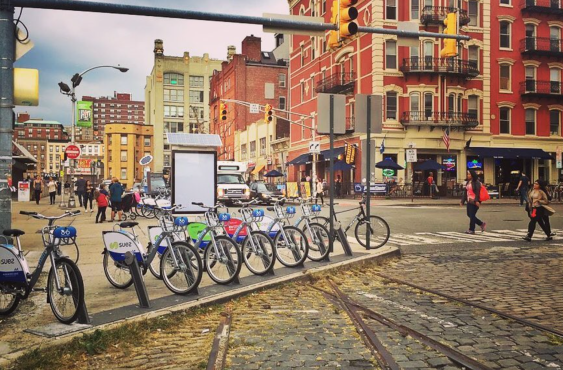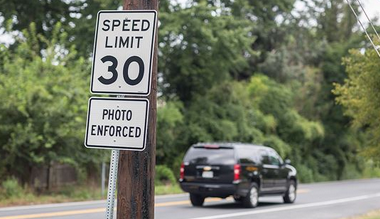On Wednesday, Wired published an 1,800-word article devoted to solving the "critical" dilemma of how to keep electric vehicle fleets charged in dense urban areas.
Authors Aarian Marshall and Matt Simon consider a range of strategies to extend the, well, range of the average EV, including classifying EV charging as "a taxpayer-funded public good" that would lead to installing charging stations on public utility poles, convincing apartment developers and managers to install them on existing lots and newly built spaces with publicly subsidized rebates, and converting gas stations to rapid-charging hot spots rather than putting that land to other uses.
Whole paragraphs are devoted to the dangers of "charging deserts," which the authors fret will leave the poor stranded unless the government subsidizes them on their journey to personally owned electric automobility and all the staggering debt, insurance, and maintenance burdens that come with it. (The average electric vehicle costs $56,437, or more than three times the annual income of a household of two living at the federal poverty line.)
"The goal is clear: Build more chargers," Marshall and Simon write. "But in dense places, the eternal question is, where?"
For sustainable transportation advocates, the answer may seem pretty obvious: at the bus depot. But the article does not mention electric buses until its very last paragraph, when the authors finally concede that "maybe you don’t have to own an EV to enjoy one." Walking, biking, and other forms of non-automotive mobility are not mentioned at all, save a one-sentence acknowledgment that putting every American into a car would probably be "dangerous for pedestrians" and "undercut the demand for public transit." (Spoiler alert: they are already are.)
We don’t just need electric cars, we need fewer cars https://t.co/6WMzBeA28O
— Greenpeace International (@Greenpeace) January 25, 2022
To #TransformTransport cities must prioritize sustainable travel by improving infrastructure that supports active mobility solutions, such as cycling and walking. pic.twitter.com/EwNyjmEYEX
From the moment pundits first forecast that electric vehicles would replace America's gas-powered fleets — which, to be clear, they undoubtedly should — an incalculable quantity of ink has been spilled on how to supply U.S. drivers with the electrical power they'll soon need.
Far less attention beyond these pages has been paid to the question of demand, and why reducing the country's appetite for automobiles must be a part of the solution to the EV charging problem, particularly in dense, urban areas with the most potential to get people onto greener modes. And even less discourse has been devoted to the ways that the most-popular EV charging solutions would further enshrine the private automobile into city life — at least if cities aren't careful.
Many of the solutions that Marshall and Simon explore could easily fall into that category. When the authors opine, for instance, about the need to "convince apartment developers and managers to buy into the unfamiliar and expensive process of installing" charger-equipped parking spaces, they don't even mention how those incentives and requirements will affect housing prices — especially for those who don't drive. Decades of scholarship have shown that when developers are required to build and maintain residential parking spaces (or even just "convinced," through the publicly subsidized tax credit and rebate programs that Marshall and Simon laud), rents go up by as much as 25 percent for buildings that supply the industry-standard two spots per unit.
Those costs will only swell when developers begin installing high-voltage plugs in addition to laying asphalt, and they'll still be passed onto renters, either in the form of rent increases, through their tax bills, or both. Adding charging to existing surface parking, meanwhile, will essentially lock in that land to a single use, unless a developer can overcome the sunk-cost fallacy of ripping out a piece of equipment that cost them thousands to install, possibly including spendy updates to their building's electrical system.
Don't say "Parking Requirements"
— Parking Reform Network (@Parking_Reform) May 17, 2021
Instead use "Costly Parking Mandates"
The language we use evokes emotion and mental short cuts; we like to create coherent stories. Framing the story of parking reform in a compelling way will help us succeed. pic.twitter.com/B5rUDWqYHO
Some of the most baffling solutions that win Marshall and Simon's praise are those that would install chargers on public property, rather than in the garages of the 64 percent of U.S. households who have access to at least one covered spot of their own.
For instance, the authors applaud U.S. cities for "[swiping] bright ideas from Europe" like "installing chargers next to curbside spots, sometimes even on street lights," ignoring the fact that doing so essentially commits a city to maintaining on-street parking in perpetuity — even if that land could someday be transformed into a bike lane, or a sidewalk cafe, or more sidewalk space, or anything else a community needs. That argument also ignores that putting chargers on public land essentially "convert[s] automotive refueling from what is now a private transaction on a private space (a gas station) to one that allocates yet more free public space (at the curb and the sidewalk) to the automobile," as New York pedestrian advocate Christine Berthet recently wrote.
In the Wired authors' estimation, though, even gas stations don't really need to go when the EV revolution comes — because they could be converted to rapid-charging stations for the handful of drivers that aren't gifted easy access to a port at home, or for any motorist who needs to charge on the fly.
And if those stations happen to be located in dense, urban neighborhoods that are desperate for developable land to turn into housing, or grocery stores, or any other essential service? Apparently, that doesn't outrank the importance of keeping a charger on every corner ... and in every garage ... and in every on-street parking space, where they are all likely to remain forevermore.
EVs are the future of cars, but cars are not the future
— Alex Lee 李天明 (@alex_lee) January 16, 2022
Here's the thing: America's urban EV charging plans don't have to replicate the mistakes we made the last time we retrofit our cities around the gas-powered automobile. And done right, the EV revolution could be a generational opportunity not just to ditch gas, but to put cars at the bottom of the city transportation hierarchy where they belong.
Instead of worrying about "charging deserts" in low-income neighborhoods whose residents struggle with the costs of car ownership as it is, we could focus our funding for public transit, walking, biking, and land use reform on those very communities, and give residents the best package of non-automotive mobility options that (public) money can buy.
Instead of ripping out street trees and juicing up light poles to better line our roads with public ports, we could convert those same parking lanes to protected bike lanes or generous sidewalks or BRT lanes that help everyone get where they need to go.
Instead of requiring developers to build "green" parking spots where they might not have otherwise built parking at all, we could compel them to provide bike parking, or subsidized transit passes, or simply to build new housing near existing transit lines.
The internal combustion engine is on its way out, and accommodating that seismic shift will revolutionize the way we live — particularly in dense cities that should have ditched the vast majority of their parking long before electric cars became a commercial reality. And particularly for those communities, to quote Marshall and Simon, "the goal is clear": to expand access to active and shared mobility options that are green, safe, convenient, affordable, and attractive to the residents they serve.
Or, at least, it should be.





